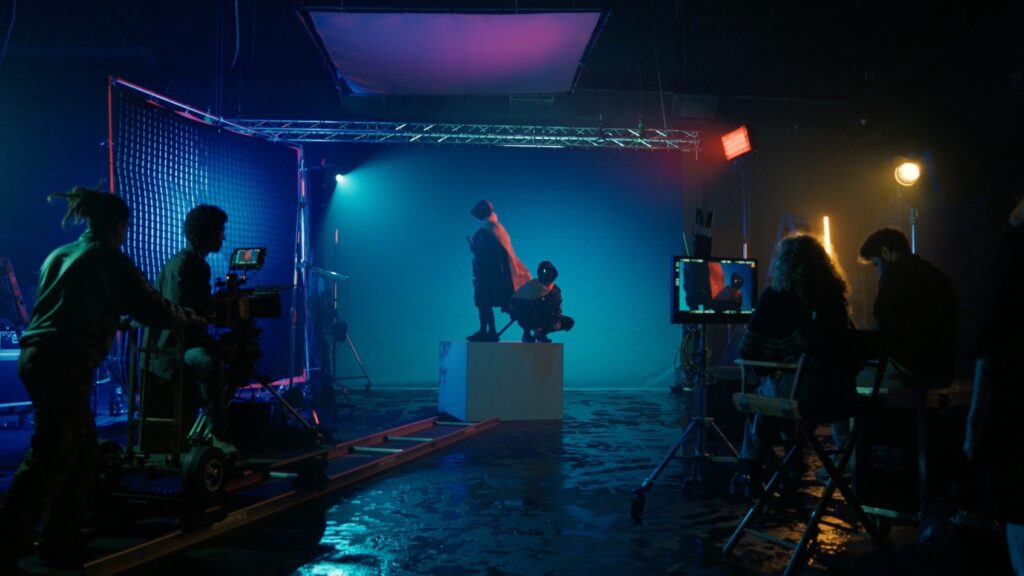Video production is a nuanced process, encompassing the crafting of visual content for diverse purposes like advertising, marketing, entertainment, and education. Merging storytelling with technical finesse, its goal is to captivate audiences while conveying compelling messages. Whether creating a commercial, a music video, or a documentary, video production services are pivotal in translating concepts into impactful visual narratives. So, what does video production do exactly? It synthesises creativity and technical acumen to breathe life into ideas and communicate messages effectively.
A professional video production company handles all aspects of the production, from planning and scripting to shooting, editing, and distribution. They use a combination of creative techniques, equipment, and software to produce high-quality videos that captivate viewers. The process requires a careful balance of art and science, with a focus on visual storytelling and technical execution.
Key Takeaways:
- Video production involves the creation of visual content for advertising, marketing, entertainment, and education.
- A professional video production company handles all aspects of the production process.
- The process combines creative storytelling with technical expertise.
- Video production aims to engage the audience and deliver a powerful message.
- It requires a careful balance of art and science.

The Key Elements of Video Production
Video production is a multi-step process that involves various elements to create compelling visual content. Understanding the key elements of video production is essential for producing high-quality videos that engage audiences and deliver messages effectively.
Planning
The planning stage is the foundation of video production. It involves defining the purpose of the video, identifying the target audience, crafting the message, setting a budget, and establishing a timeline. Proper planning ensures that the video aligns with the goals and objectives of the project and helps in creating a roadmap for the rest of the production process.
Shooting
Once the planning is complete, the shooting stage begins. This is where the visual and audio elements of the video are captured using appropriate equipment and techniques. The choice of cameras, lighting, sound recording, and other technical aspects play a crucial role in ensuring that the footage is of the highest quality. Skilled videographers or cinematographers are responsible for capturing the desired shots and ensuring visually appealing aesthetics.
Editing
After the footage is captured, it goes through the editing stage. This is where the raw footage is transformed into a coherent and compelling story. Skilled video editors select the best shots, arrange them in a logical sequence, and add transitions, effects, and sound to create a polished final product. Editing allows for refining the video, enhancing its visual appeal, and ensuring a smooth flow that engages the audience.
Distribution
Once the video is edited to perfection, it is ready for distribution. This involves delivering the final product to the intended audience through various channels such as social media platforms, websites, or television. Effective distribution strategies can help maximise the reach and impact of the video, ensuring that it reaches the target audience and achieves its intended goals.
| Key Elements | Description |
|---|---|
| Planning | Defining the purpose, target audience, message, budget, and timeline of the video. |
| Shooting | Capturing the visual and audio elements using the right equipment and techniques. |
| Editing | Selecting and arranging the footage to create a coherent story and adding transitions, effects, and sound. |
| Distribution | Delivering the final video to the audience through various channels. |
Understanding the video production process and its key elements is crucial for creating impactful videos that resonate with the audience. By carefully planning, capturing compelling footage, skillfully editing, and effectively distributing the video, businesses can harness the power of video production to tell their stories and achieve their communication goals.
Balancing Art and Science in Video Production
Successful video production requires a delicate balance between the art of storytelling and the science of technical execution. It involves employing various techniques to create visually captivating content that engages the audience. Here are some essential video production techniques to consider:
1. Capturing Cinematic Shots
One of the key elements of video production is capturing cinematic shots that add depth and visual appeal to the footage. Techniques such as the rule of thirds, leading lines, and creative camera movements can elevate the overall quality of the video. By employing these techniques effectively, you can create a visually stunning piece that holds the audience’s attention.
2. Effective Use of Lighting
Lighting plays a crucial role in video production as it sets the mood, enhances the atmosphere, and directs the viewer’s attention. By understanding different lighting techniques, such as three-point lighting and natural lighting, you can create the desired visual impact. Properly lit scenes can make a significant difference in the overall aesthetic of the video.
3. Framing Subjects
The way subjects are framed within the camera’s frame can greatly impact the storytelling aspect of a video. By carefully composing shots and utilising techniques like the rule of thirds, leading lines, and symmetrical or asymmetrical framing, you can guide the viewer’s focus and evoke specific emotions.
Staying up-to-date with industry trends is crucial in the ever-evolving world of video production. From advancements in equipment to new software releases and emerging visual effects, keeping abreast of the latest trends helps ensure your video production remains fresh and relevant. Incorporating these trends into your creative process can help you stay ahead of the competition and deliver high-quality videos that captivate your audience.
| Video Production Industry Trends | Description |
|---|---|
| Virtual Reality (VR) and Augmented Reality (AR) | The rise of VR and AR technologies presents new opportunities for immersive storytelling and interactive experiences. |
| Live Streaming | Live streaming has gained popularity, allowing brands and individuals to connect with their audience in real-time. |
| 360-Degree Video | 360-degree video offers a unique perspective, allowing viewers to explore the entire environment captured by the camera. |
| Short-Form Content | The popularity of platforms like TikTok and Instagram has led to a demand for concise, attention-grabbing videos. |
By incorporating these video production techniques and staying informed about industry trends, you can create videos that are visually compelling, engaging, and relevant to your target audience.
Tips for Successful Video Production
When it comes to successful video production, there are several key tips to keep in mind. Firstly, it’s crucial to know your target audience and create a video that resonates with them. Understanding their interests, preferences, and needs will help you craft a video that engages and captivates their attention.
Another important aspect is keeping the story simple. Complex narratives can sometimes confuse viewers, so focus on a clear and concise message that is easy to follow. Utilise visuals and sound effectively to enhance audience engagement and create an emotional connection.
Testing and refining your video based on analytics and feedback is also essential. Pay attention to metrics such as viewer retention, click-through rates, and comments to understand what is working and what needs improvement. This data-driven approach will help you optimise your video for maximum effectiveness.
Best Practices for Successful Video Production
- Understand your target audience and create content that resonates with them.
- Keep the story simple and clear to avoid confusion.
- Use visuals and sound effectively to enhance audience engagement.
- Test and refine your video based on analytics and feedback.
- Stay updated on platform-specific video optimisation techniques.
- Utilise high-quality thumbnails to attract viewers.
Remember, the goal of video production is to deliver a compelling message that engages the audience. By following these tips and best practices, you can create videos that captivate viewers and achieve your business goals.
Table: Top Video Production Tips
| Tips | Description |
|---|---|
| Know your audience | Understand the interests and preferences of your target audience to create content that resonates with them. |
| Keep it simple | Create a clear and concise story that is easy to follow, avoiding complex narratives that may confuse viewers. |
| Use visuals and sound effectively | Utilise compelling visuals and high-quality sound to enhance audience engagement and emotional connection. |
| Test and refine | Analyse video performance data and gather feedback to improve and optimise your video for maximum effectiveness. |
| Stay updated on optimisation techniques | Keep up with platform-specific video optimisation techniques to ensure your videos reach their full potential. |
| Utilise high-quality thumbnails | Attract viewers with visually appealing thumbnails that represent the content of your video. |
Conclusion
Video production is a crucial and dynamic field that serves a variety of purposes. It combines the art of storytelling with technical skills to engage audiences and effectively deliver messages. Understanding the key elements of video production, such as planning, shooting, editing, and distribution, is essential for creating compelling visual content.
Successful video production requires a delicate balance between art and science. By incorporating techniques such as capturing cinematic shots, using effective lighting, and framing subjects creatively, videos can achieve a higher artistic quality. Keeping up with industry trends in equipment, software, and visual effects is also important in maintaining relevance and staying ahead in the ever-evolving video production landscape.
Following best practices and considering audience preferences are key to achieving success in video production. Understanding the target audience and crafting videos that resonate with them can significantly enhance engagement. Testing and refining videos based on analytics and feedback are vital processes for optimising their effectiveness.
Video production is a dynamic and powerful tool for businesses and individuals alike. By understanding its importance and constantly adapting to industry trends, video production can continue to captivate audiences, deliver impactful messages, and achieve desired goals.
FAQ
What is video production?
Video production is the art and science of creating visual content for advertising, marketing, entertainment, and education.
What are the key elements of video production?
The key elements of video production include planning, shooting, editing, and distribution.
How do you balance art and science in video production?
Balancing art and science in video production involves techniques such as capturing cinematic shots, using lighting effectively, and keeping up with industry trends in equipment and software.
What are some tips for successful video production?
Some tips for successful video production include knowing the target audience, creating a video that resonates with them, and testing and refining the video based on analytics and feedback.
Why is video production important?
Video production is important because it combines storytelling with technical skills to engage audiences and deliver messages effectively.
Source Links
- https://www.splento.com/blog/videography/the-art-and-science-of-telling-stories-through-video-production/
- https://www.emotionvideo.com.au/unveiling-the-secrets-mastering-smartphone-videography-for-pro-level-results/
- https://mediaborne.co.uk/how-to-grow-your-youtube-channel-in-2023-video-production-company-blog/





